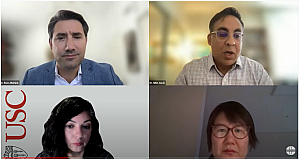Global Cinema Panel Discussion
The Meridian Center for Cultural Diplomacy hosted a panel discussion to explore how film has been used as a tool in public diplomacy. Panelists specialized in various areas of global cinema to speak to how it is a vehicle for soft power:
- Dr. Ross Melnick, professor of Film and Media Studies at University of California, Santa Barbara, moderated this discussion. His new book, Hollywood's Embassies: How Movie Theaters Projected American Power Around the World, shows how the entanglement of worldwide movie theaters with the American empire offers a new way of understanding film history and the history of U.S. soft power.
- Dr. Hye Seung Chung, a professor of film and media studies at Colorado State University who recently published a book, Hollywood Diplomacy: Film Regulation, Foreign Relations, and East Asian Representations, that examines Hollywood’s internal regulation, external government foreign relations, and how cinema built relationships through diplomatic representations of race, nationality, and ethnicity.
- Dr. Nitin Govil, an associate professor of Cinematic Arts at the University of Southern California School of Cinematic Arts. His recently published book, Orienting Hollywood: A Century of Film Culture between Los Angeles and Bombay, examines the long history of social connections between Hollywood and Bombay cinema.
- Dr. Laura Isabel Serna, author of Making Cinelandia: American Films and Mexican Film Culture before the Golden Age. Dr. Serna’s research explores the impact American film has on Mexican audiences and how the film industry influenced Mexican migration.
Below are the top takeaways from the program:
1. Creative Freedom and a Global Audience. Dr. Hye Seung Chung opened the conversation by exploring the definition of what “creative freedom” actually means for the American cinema industry, which is responsible to a global audience. She highlighted the irony that China, India and Japan make up the largest markets for American cinema and yet depictions of these communities and locations have often been reduced to harmful stereotypes. Dr. Chung stated that a main throughline in her research, “is that creative freedom is not an entitlement to offend your biggest customers. True creative freedom is the opportunity to forge better relationship with our global partners.”
2. Hollywood Diplomacy is Nothing New. Dr. Nitin Govil’s research looks to the past for examples of cultural exchange between Hollywood and Bollywood that go beyond the usual narrative of these two leaders in the film industry. One example of cultural diplomacy that sticks out to Dr. Govil is the exchange of film stars in the 1950s during the Cold War; President Truman’s Ambassador to India enlisted American director Frank Capra to attend the first Indian International Film Festival in 1952 to get a sense of India’s political and cultural leanings during this crucial moment in history. Later that year, Indian film stars toured the U.S. for 10 days, visiting football games and Hollywood galas. Dr. Govil’s work emphasizes that these early exchanges are integral to understanding the contemporary relationship between the India and the U.S.
3. Modernity in Mexico through American Films. Dr. Laura Isabel Serna’s research explores the reception of American cinema in Mexico following World War I, when American film dominated the Mexican market. Some cultural critics at the time were concerned that this cultural imperialism would erase Mexican culture, but popular reception at the time complicates this narrative. Dr. Serna asserts that American cinema also served as an exemplar of modernity for Mexican audiences. Before her archival research, Dr. Serna expected to find Mexican audiences resentful of the American culture spreading across their film screens, but in reality, found popular audiences seeking out American films as a model to experiment with newer gender identities and social relationships.
4. Cinematic Censorships in China. Dr. Chung also detailed the push and pull of censorship of American films in China. Dating back to the silent era in films, there have been protests and embargos due to harmful Asian representation in Hollywood movies. Dr. Chung elaborated on the cyclical nature of this issue: where there are protests around Asian representation in a film, the film is edited in response to temper the reception of a global audience, followed by American production companies making hesitant promises to improve representation on future projects. Dr. Chung noted that there has never been a uniform policy and it’s a case-by-case basis for censorship based on racist stereotypes in American film or Chinese political motivations. Dr. Chung believes these conflicts should be seen as opportunities to think about long-term policy regarding censorship.
5. Diplomacy on Set. Dr. Serna’s research also delves into how Hollywood’s stereotypes and static depictions of Mexico have been a point of contention throughout film history. Mexico viewed these depictions as a public image problem and worked with Hollywood and the U.S. State Department to soften these images through diplomatic channels and consultants on-set. She concludes that these stereotypes, “can interrupt the soft power of culture to create bonds, but also become this moment of negotiation and working together to create acceptable images.” While Dr. Serna explained the negotiations happening at the national level in Mexico, Dr. Govil chimed in that filming on locations around the world also creates opportunities for cultural connections at the people-to-people level. He highlighted that shooting in a new location can bring conflict between local partners and Hollywood productions that cannot be foreseen by the State Department or Hollywood. However, these present an opportunity for, “a new kind of diplomacy to be engineered on the fly.”
Project summary
| Global Cinema Panel Discussion | March 2022 | |
|---|---|
| Impact Areas: | Cultural Diplomacy, Media and Journalism |
| Program Areas: | Culture |
